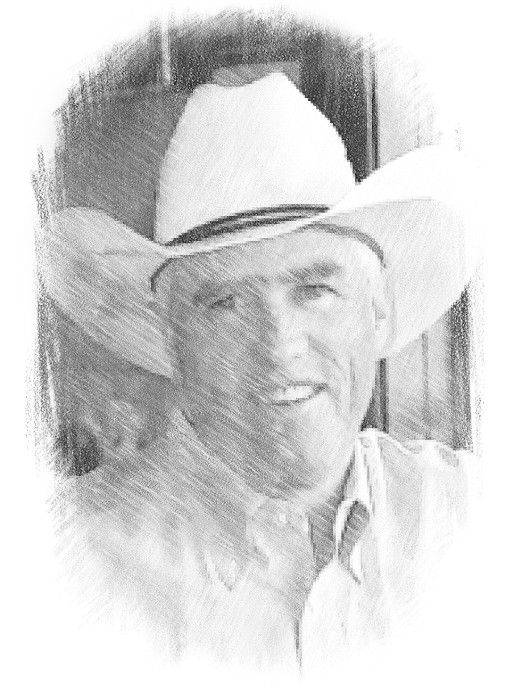
Bill Anton
(b.1957)
“I do not see myself as a biographer of the cowboy. I know some artists feel they are recording a historical portrayal of ranch life today in the American West. But the focus of my work has always been mood and passion. If I’m recording anything, I’m recording how I feel about the West. I want the viewer to feel the drama of atmosphere and the mystery of a western night. I want the volume and portent of a cloud to be evident in the calligraphy of a brush stroke. The pack of the muscle below a horse’s shoulder should be energized by the gestural application of paint.
You see, I love to paint. And I love the American West. I was born in Chicago, but the Sierra Nevada, Sangre de Cristo, Sawatch and a hundred other ranges of our Rocky Mountains were the only “big shoulders” that ever interested me. Walking thunderstorms, sunstruck cedars, rimrock and artfully abstract water patterns charge the landscape here with an impossible beauty.
Amidst this nobility is its caretaker: the rancher. With the natural ease of generations bred to the saddle, he is a powerful image, further ennobled by a fine horse. An artist under the spell of the west has the privilege of marshaling the virtues of landscape, figure and equine painting into one supremely paintable subject: the American cowboy. TO GOD BE THE GLORY”
Source: Bill Anton
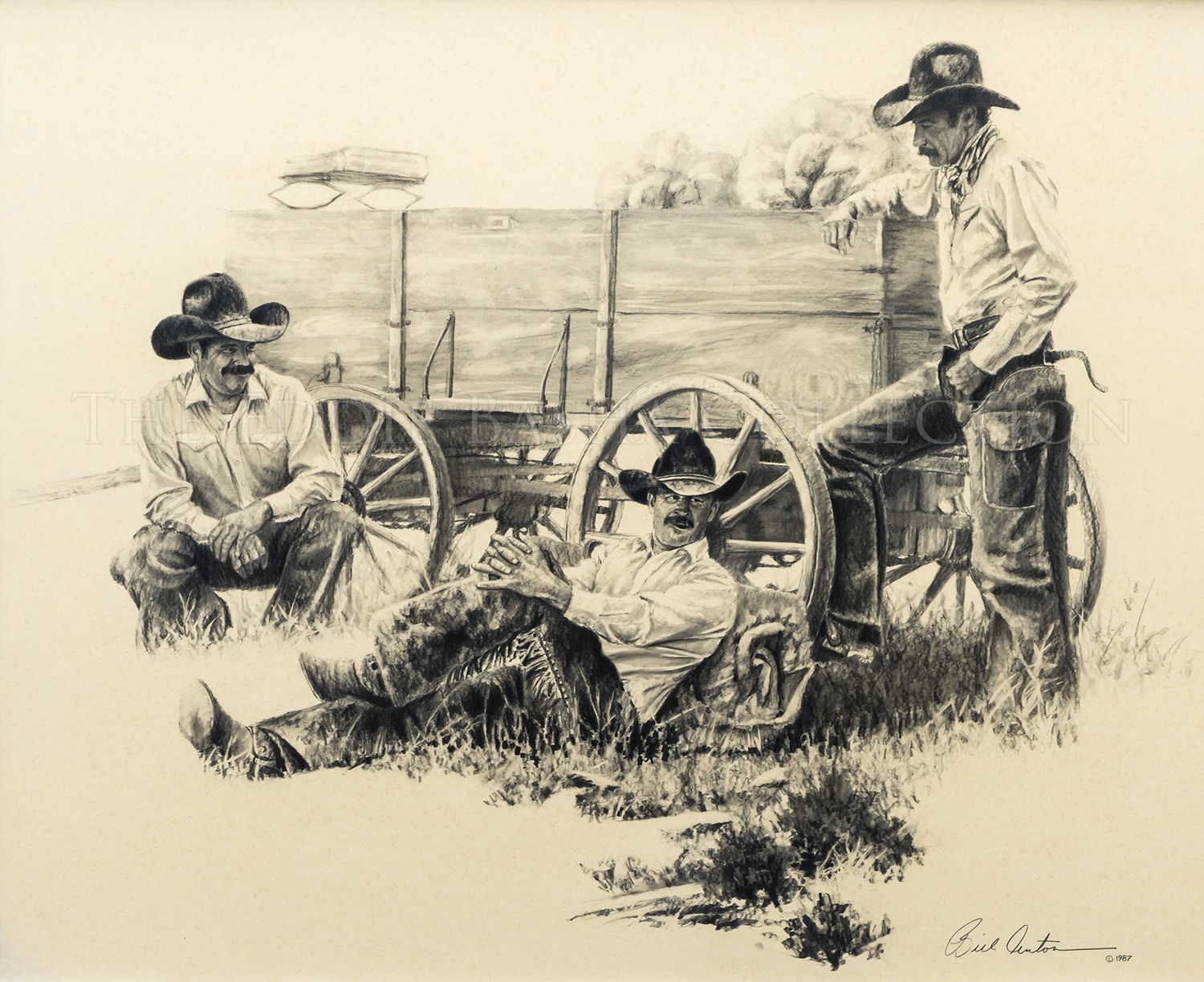
Would I Lie To You
Artist: Bill Anton (b.1957)
Description: Pencil (1987) | Image Size: 22”h x 27 ½”w; Framed Size: 26”h x 31 ½”wdrawing
In this amusing composition, Bill Anton welcomes the viewer into a circle of three cowboys effectively making the viewer a participant in some good-natured storytelling. The setting is relaxed and congenial; Anton effectively shows the camaraderie between ranch hands that have likely traveled across many pastures together. While many of Anton’s scenes of ranch life portray cowboys at work, often alone, this drawing presents another side to their day-to-day activities. These three cow hands have temporarily put aside the work to spin a few yarns and tell a few tall tales for their own enjoyment. The focus is entirely on the cowboys; there isn’t a true background, and the wagon serves to frame the characters. It is a simple arrangement, but Anton shows his ability to tell a story himself using characters that one might encounter on any given ranch.
“Would I Lie to You” returned to the gallery in June after having been on loan to the Arizona State Capitol Speaker’s Office (2019-2022).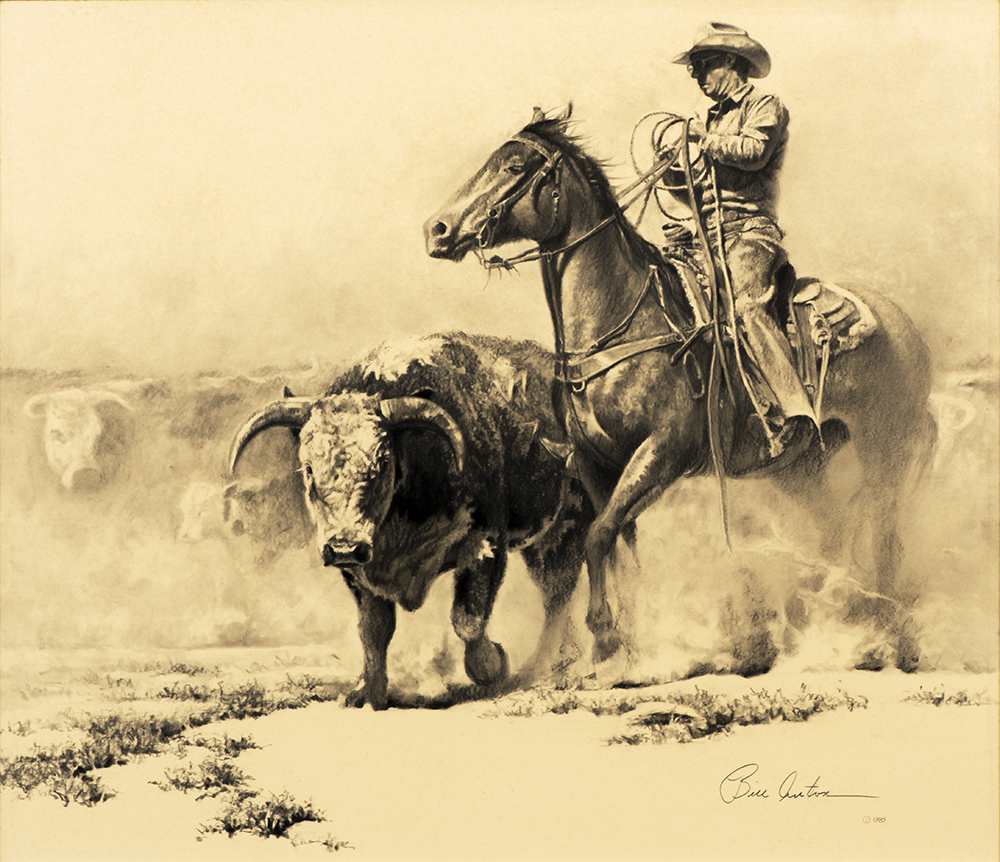
The Right of Way
Artist: Bill Anton (b.1957)
Description: Pencil (1985) | Image Size: 22”h x 25”w; Framed Size: 29 ¼”h x 32 7/8”wpainting
Bill Anton is a keen observer of modern day ranch work and has the artistic skill to turn those observations into compelling, action-filled vignettes that give the viewer a true sense of reality. His cowboys are real people and his talent at capturing the details of everyday ranch work is well evident. Here, Anton places a mounted cowboy, rope in hand, near a steer that has been cut out from the herd, the background is obscured in a cloud of dust. The effect is to silhouette the rider and cow as the focal points of the drawing, keeping the viewer’s attention on the task at hand.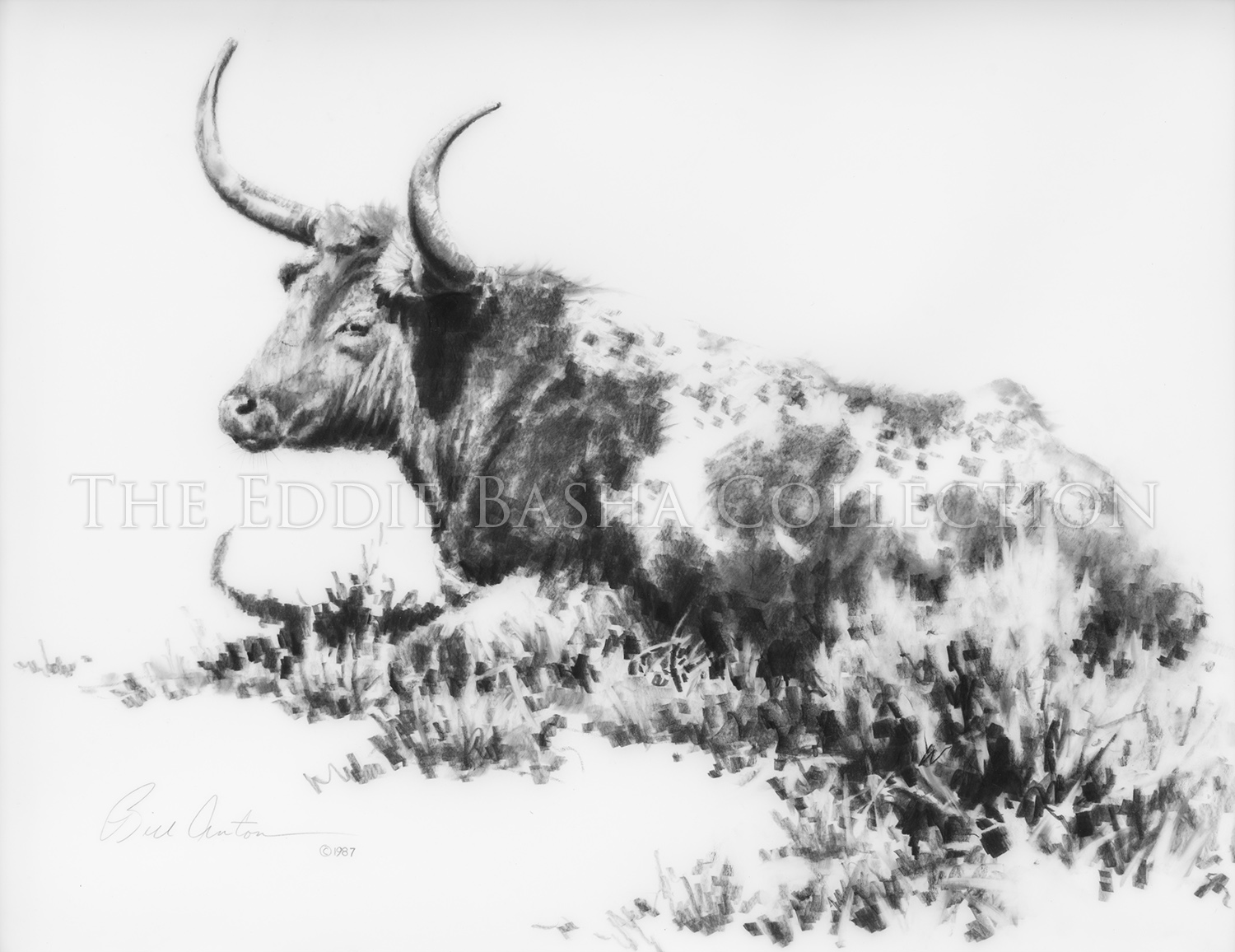
Unknown Title
Artist: Bill Anton (b.1957)
Description: Pencil (1987) | Image Size: 11”h x 14”w; Framed Size: 17 ½”h x 20 ½”wpainting
A relatively simple composition that is an excellent study of both the anatomy and personality of its subject. Every cowboy knows that each animal under his care is different, and Anton is careful to show the unique disposition and habits of each animal in his livestock portraits.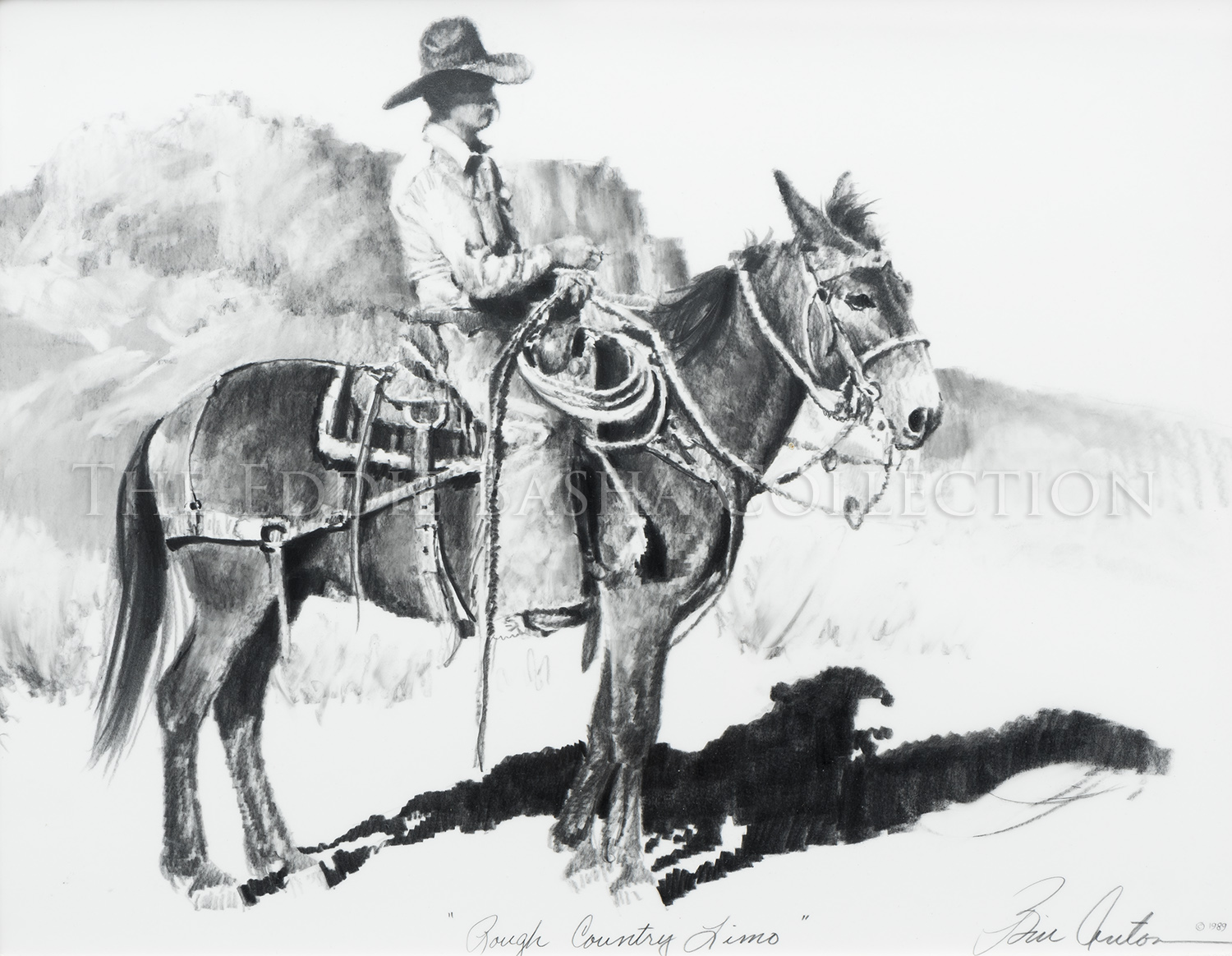
Rough Country Limo
Artist: Bill Anton (b.1957)
Description: Pencil (1989) | Image Size: 11”h x 14”w; Framed Size: 18 ¾”h X 21 ¾”wpainting
Though small and a relatively simple drawing, “Rough Country Limo” effectively captures both mule and rider in a realistic fashion. And its title is sure to put a smile on all our faces.
As always, Anton adds enough authentic details of the cowboy’s clothes and tools and the rigging on the mule to let the viewer know that this is a scene that could be found on many ranches almost any day. The landscape serves as a contrasting backdrop to the clearly drawn rider and Anton’s use of the stark shadow adds another highly realistic detail.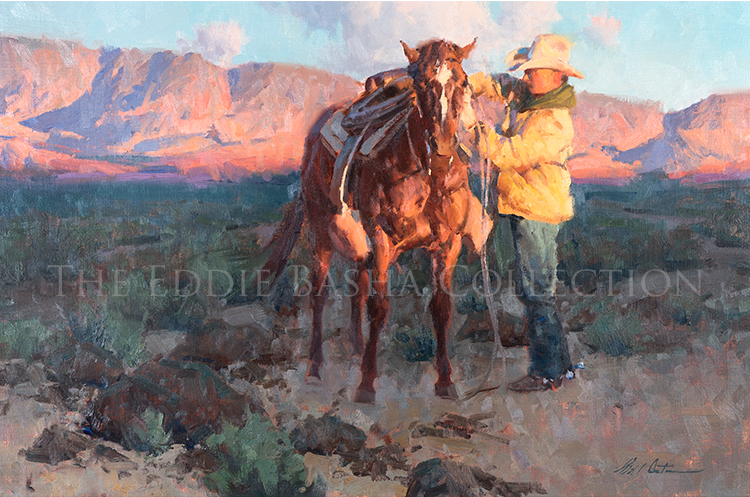
West of Wikieup
Artist: Bill Anton (b.1957)
Description: Oil | Image Size: 24”h x 36”w; Framed Size: 33”h x 45 ½”wpainting
Many of Bill Anton’s prodigious talents as a western artist are displayed in this painting of a cowboy readying his mount for another long stint in the saddle. Both cowboy and horse are depicted in rich detail from the horse’s gear to the cowboy’s clothing. The most dramatic effect used in this painting is the contrast between the bright sunlit mountains in the background and the dark foreground. The viewer comes upon this scene just as the landscape is transitioning from darkness to brilliant sunlight, revealing a wealth of rich colors and dramatic shapes and forms. Anton also uses sunlight to focus attention on the upper halves of both horse and rider.
While there is no action or movement in this scene, the changing sunlight gives a sense of time passing and adds a touch of drama to the unfolding story being told. Most likely by the time the cowboy has finished preparing his mount, the true glory of the landscape surrounding him will be revealed. The story that is left for the viewer to ponder is what sort of day awaits this pair.
Wikieup is a small Arizona town of approximately 350 people in the Big Sandy Valley of Mohave County southeast of Kingman. The area was originally home to settlements of Hualapai and nearby Mohave Indians who grew corn and other crops. Wikieup is a Mohave word meaning shelter or home. When Wikieup’s founders were organizing, there was a shelter made of grass and branches near the site of the proposed post office.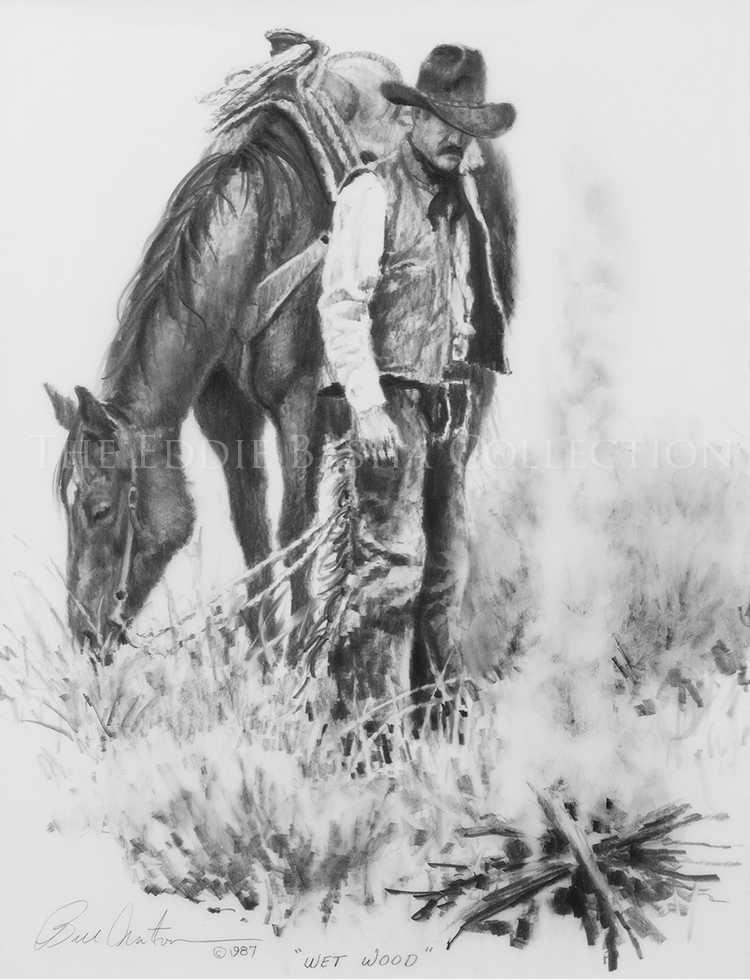
Wet Wood
Artist: Bill Anton (b.1957)
Description: Pencil (1987) | Image Size: 14”h x 11”w; Framed Size: 20 ½”h x 17 ½”wdrawing
This nicely done drawing with a hint of humor sums up the plight of the cowboy in the scene. Bill Anton has shown us once again he can find worthy subject matter even in the most mundane of circumstances—a cowboy attempting to warm himself by starting a campfire with damp firewood. The resulting smoldering and smoky fire has most likely been experienced by many people. The wrangler’s posture and his downward gaze speak volumes about the kind of day he has likely had. The dismounted cowboy and his still saddled horse dominate the bulk of the scene with the horse looking as if he has a better handle on the situation than the cowboy. The rising smoke effectively tells the viewer that this process could likely take a while.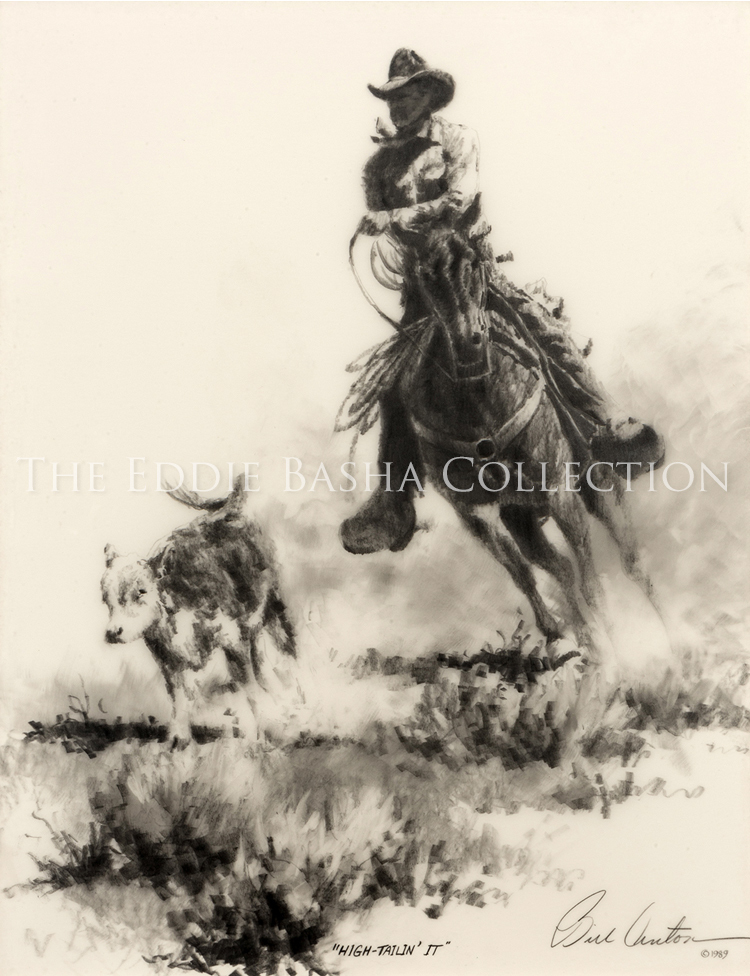
High Tailin’ It
Artist: Bill Anton (b.1957)
Description: Pencil (1989) | Image Size: 14”h x 11”w; Framed Size: 21 ¾”h x 18 ¾”wdrawing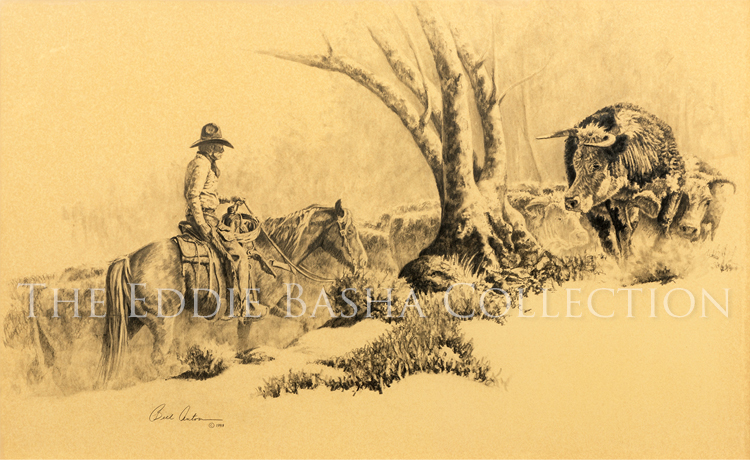
Up To Summer Ranges
Artist: Bill Anton (b.1957)
Description: Pencil (1984) | Image Size: 22”h x 36”w; Framed Size: 28 ¼”h x 42 3/8”wdrawing
“Up To Summer Ranges” is a relatively large drawing, and the scene is of a lone cowboy moving his cattle to higher ground. Anton has balanced the action of the scene by placing the mounted rider on one side of a tree that dominates the foreground and the most prominent feature, the lead steer, on the other side giving the impression that the steer has just made the turn around the tree and will continue toward the viewer and out of the viewing frame. The balance of the herd is shown obscured in dust behind the main figures conveying a sense of continuous movement. The action here is steady, but not hurried. The implication is that this activity is a regular occurrence of working cattle on a modern ranch.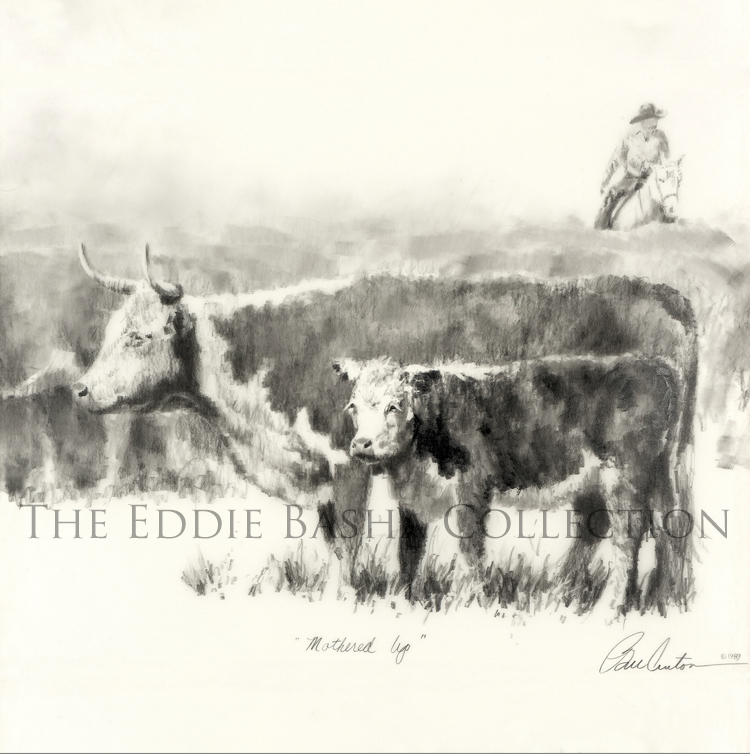
Mothered Up
Artist: Bill Anton (b.1957)
Description: Pencil (1989) | Image Size: 11”h x 14”w; Framed Size: 19”h x 22”wdrawing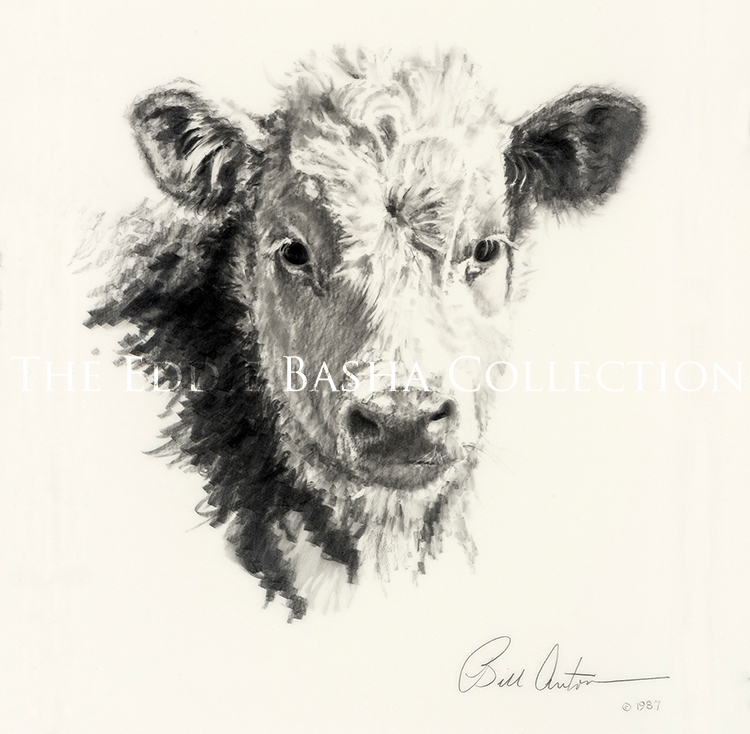
Calf Portrait
Artist: Bill Anton (b.1957)
Description: Pencil (1987) | Image Size: 14”h x 11”w; Framed Size: 20”h x 17”wdrawing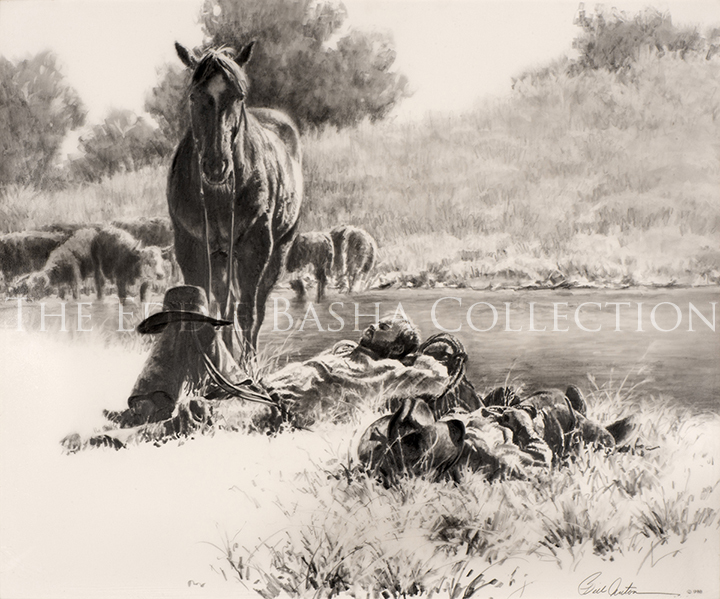
Somebody’s Afoot
Artist: Bill Anton (b.1957)
Description: Pencil (1988) | Image Size: 20”h x 24”w; Framed Size: 28 ½”h x 32 ½”wdrawing
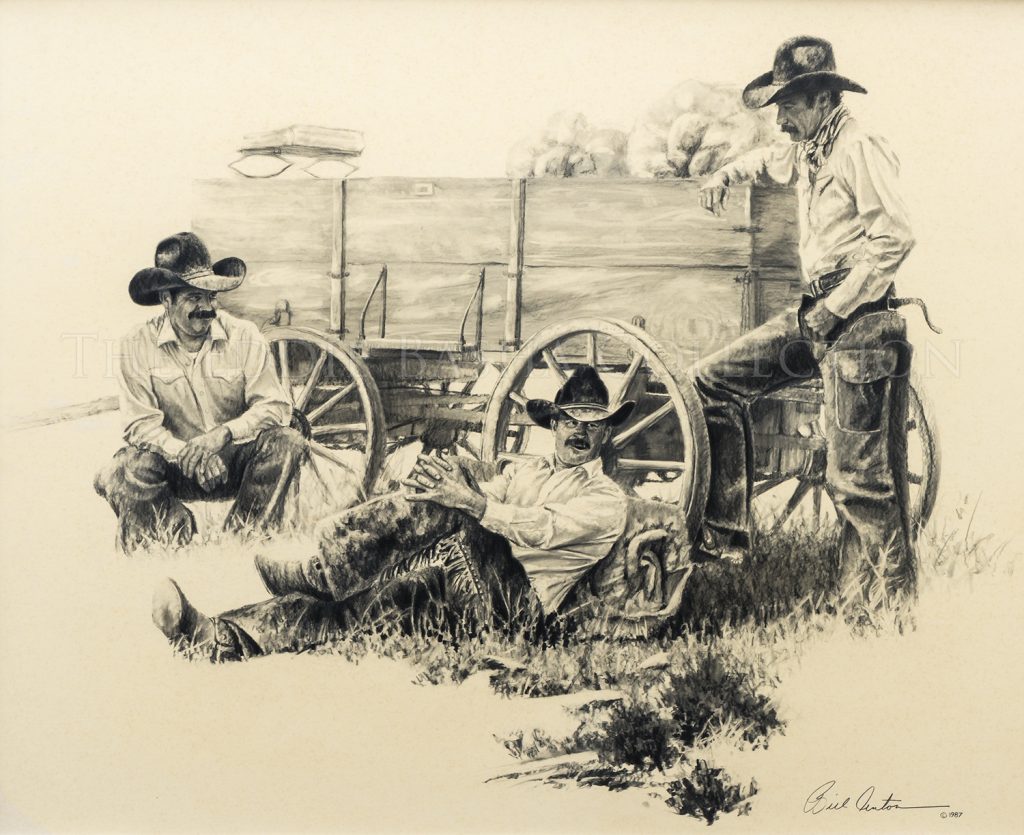 Pencil (1987) | Image Size: 22”h x 27 ½”w; Framed Size: 26”h x 31 ½”w
Pencil (1987) | Image Size: 22”h x 27 ½”w; Framed Size: 26”h x 31 ½”wIn this amusing composition, Bill Anton welcomes the viewer into a circle of three cowboys effectively making the viewer a participant in some good-natured storytelling. The setting is relaxed and congenial; Anton effectively shows the camaraderie between ranch hands that have likely traveled across many pastures together. While many of Anton’s scenes of ranch life portray cowboys at work, often alone, this drawing presents another side to their day-to-day activities. These three cow hands have temporarily put aside the work to spin a few yarns and tell a few tall tales for their own enjoyment. The focus is entirely on the cowboys; there isn’t a true background, and the wagon serves to frame the characters. It is a simple arrangement, but Anton shows his ability to tell a story himself using characters that one might encounter on any given ranch.
“Would I Lie to You” returned to the gallery in June after having been on loan to the Arizona State Capitol Speaker’s Office (2019-2022).
Would I Lie To You
Artist: Bill Anton (b.1957)
In this amusing composition, Bill Anton welcomes the viewer into a circle of three cowboys effectively making the viewer a participant in some good-natured storytelling. The setting is relaxed and congenial; Anton effectively shows the camaraderie between ranch hands that have likely traveled across many pastures together. While many of Anton’s scenes of ranch life portray cowboys at work, often alone, this drawing presents another side to their day-to-day activities. These three cow hands have temporarily put aside the work to spin a few yarns and tell a few tall tales for their own enjoyment. The focus is entirely on the cowboys; there isn’t a true background, and the wagon serves to frame the characters. It is a simple arrangement, but Anton shows his ability to tell a story himself using characters that one might encounter on any given ranch.
“Would I Lie to You” returned to the gallery in June after having been on loan to the Arizona State Capitol Speaker’s Office (2019-2022).
 Pencil (1985) | Image Size: 22”h x 25”w; Framed Size: 29 ¼”h x 32 7/8”w
Pencil (1985) | Image Size: 22”h x 25”w; Framed Size: 29 ¼”h x 32 7/8”wBill Anton is a keen observer of modern day ranch work and has the artistic skill to turn those observations into compelling, action-filled vignettes that give the viewer a true sense of reality. His cowboys are real people and his talent at capturing the details of everyday ranch work is well evident. Here, Anton places a mounted cowboy, rope in hand, near a steer that has been cut out from the herd, the background is obscured in a cloud of dust. The effect is to silhouette the rider and cow as the focal points of the drawing, keeping the viewer’s attention on the task at hand.
The Right of Way
Artist: Bill Anton (b.1957)
Bill Anton is a keen observer of modern day ranch work and has the artistic skill to turn those observations into compelling, action-filled vignettes that give the viewer a true sense of reality. His cowboys are real people and his talent at capturing the details of everyday ranch work is well evident. Here, Anton places a mounted cowboy, rope in hand, near a steer that has been cut out from the herd, the background is obscured in a cloud of dust. The effect is to silhouette the rider and cow as the focal points of the drawing, keeping the viewer’s attention on the task at hand.
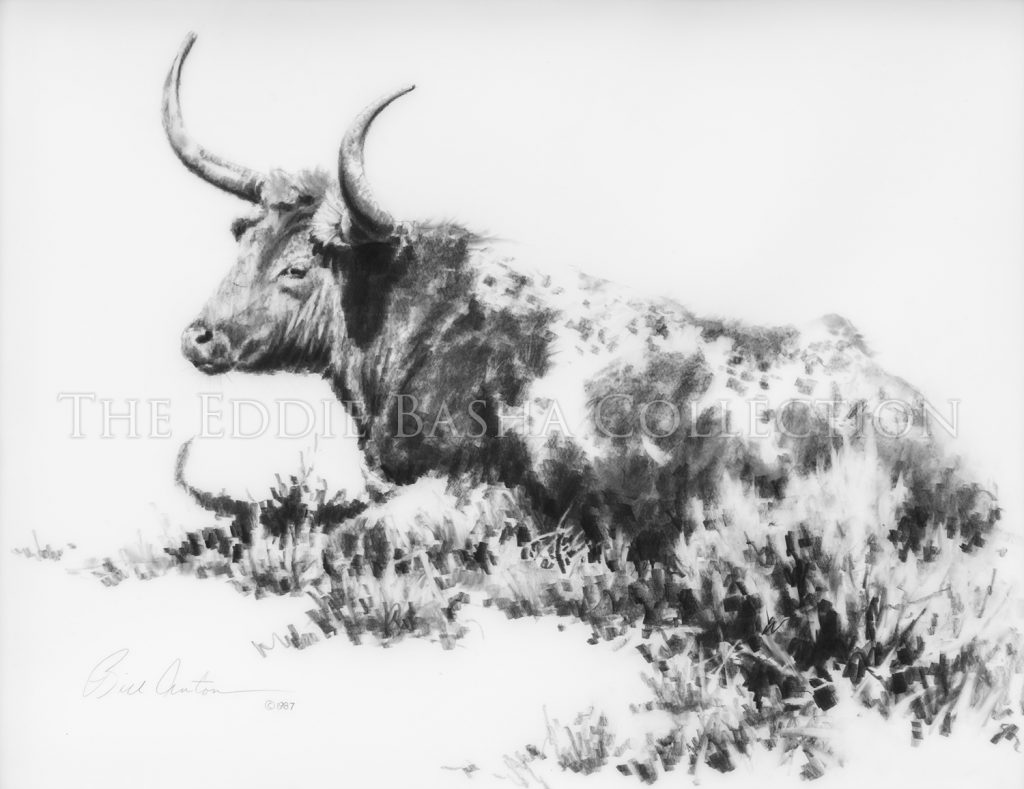 Pencil (1987) | Image Size: 11”h x 14”w; Framed Size: 17 ½”h x 20 ½”w
Pencil (1987) | Image Size: 11”h x 14”w; Framed Size: 17 ½”h x 20 ½”wA relatively simple composition that is an excellent study of both the anatomy and personality of its subject. Every cowboy knows that each animal under his care is different, and Anton is careful to show the unique disposition and habits of each animal in his livestock portraits.
Unknown Title
Artist: Bill Anton (b.1957)
A relatively simple composition that is an excellent study of both the anatomy and personality of its subject. Every cowboy knows that each animal under his care is different, and Anton is careful to show the unique disposition and habits of each animal in his livestock portraits.
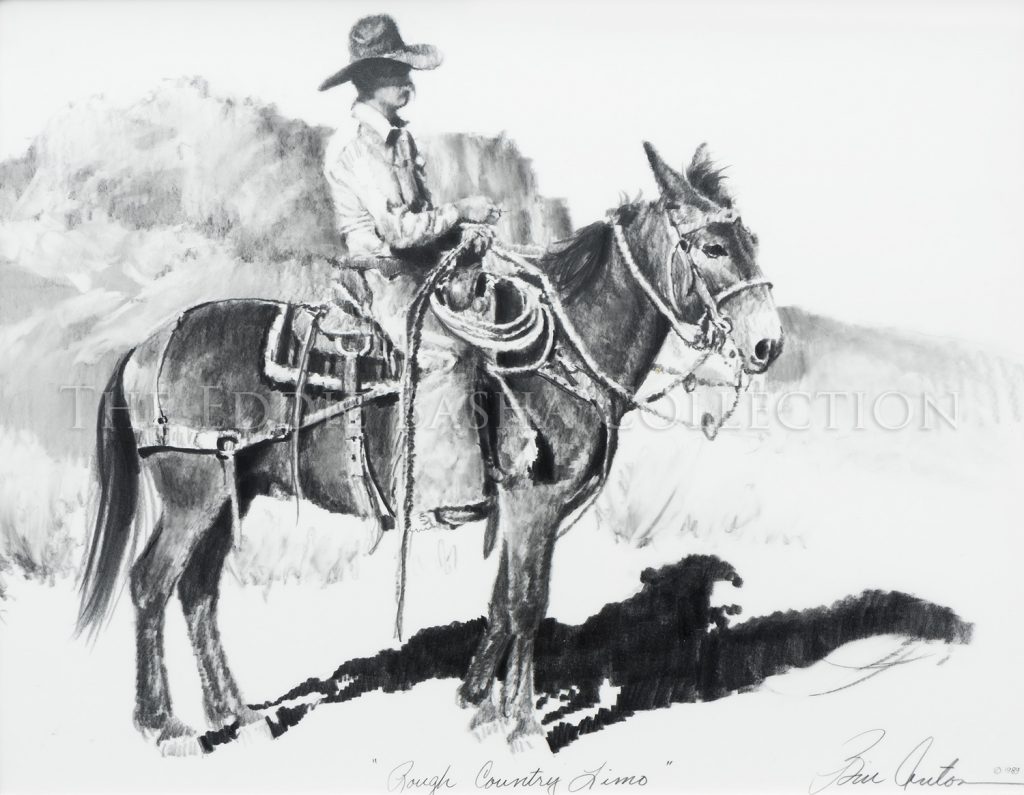 Pencil (1989) | Image Size: 11”h x 14”w; Framed Size: 18 ¾”h X 21 ¾”w
Pencil (1989) | Image Size: 11”h x 14”w; Framed Size: 18 ¾”h X 21 ¾”wThough small and a relatively simple drawing, “Rough Country Limo” effectively captures both mule and rider in a realistic fashion. And its title is sure to put a smile on all our faces.
As always, Anton adds enough authentic details of the cowboy’s clothes and tools and the rigging on the mule to let the viewer know that this is a scene that could be found on many ranches almost any day. The landscape serves as a contrasting backdrop to the clearly drawn rider and Anton’s use of the stark shadow adds another highly realistic detail.
Rough Country Limo
Artist: Bill Anton (b.1957)
Though small and a relatively simple drawing, “Rough Country Limo” effectively captures both mule and rider in a realistic fashion. And its title is sure to put a smile on all our faces.
As always, Anton adds enough authentic details of the cowboy’s clothes and tools and the rigging on the mule to let the viewer know that this is a scene that could be found on many ranches almost any day. The landscape serves as a contrasting backdrop to the clearly drawn rider and Anton’s use of the stark shadow adds another highly realistic detail.
 Oil | Image Size: 24”h x 36”w; Framed Size: 33”h x 45 ½”w
Oil | Image Size: 24”h x 36”w; Framed Size: 33”h x 45 ½”wMany of Bill Anton’s prodigious talents as a western artist are displayed in this painting of a cowboy readying his mount for another long stint in the saddle. Both cowboy and horse are depicted in rich detail from the horse’s gear to the cowboy’s clothing. The most dramatic effect used in this painting is the contrast between the bright sunlit mountains in the background and the dark foreground. The viewer comes upon this scene just as the landscape is transitioning from darkness to brilliant sunlight, revealing a wealth of rich colors and dramatic shapes and forms. Anton also uses sunlight to focus attention on the upper halves of both horse and rider.
While there is no action or movement in this scene, the changing sunlight gives a sense of time passing and adds a touch of drama to the unfolding story being told. Most likely by the time the cowboy has finished preparing his mount, the true glory of the landscape surrounding him will be revealed. The story that is left for the viewer to ponder is what sort of day awaits this pair.
Wikieup is a small Arizona town of approximately 350 people in the Big Sandy Valley of Mohave County southeast of Kingman. The area was originally home to settlements of Hualapai and nearby Mohave Indians who grew corn and other crops. Wikieup is a Mohave word meaning shelter or home. When Wikieup’s founders were organizing, there was a shelter made of grass and branches near the site of the proposed post office.
West of Wikieup
Artist: Bill Anton (b.1957)
Many of Bill Anton’s prodigious talents as a western artist are displayed in this painting of a cowboy readying his mount for another long stint in the saddle. Both cowboy and horse are depicted in rich detail from the horse’s gear to the cowboy’s clothing. The most dramatic effect used in this painting is the contrast between the bright sunlit mountains in the background and the dark foreground. The viewer comes upon this scene just as the landscape is transitioning from darkness to brilliant sunlight, revealing a wealth of rich colors and dramatic shapes and forms. Anton also uses sunlight to focus attention on the upper halves of both horse and rider.
While there is no action or movement in this scene, the changing sunlight gives a sense of time passing and adds a touch of drama to the unfolding story being told. Most likely by the time the cowboy has finished preparing his mount, the true glory of the landscape surrounding him will be revealed. The story that is left for the viewer to ponder is what sort of day awaits this pair.
Wikieup is a small Arizona town of approximately 350 people in the Big Sandy Valley of Mohave County southeast of Kingman. The area was originally home to settlements of Hualapai and nearby Mohave Indians who grew corn and other crops. Wikieup is a Mohave word meaning shelter or home. When Wikieup’s founders were organizing, there was a shelter made of grass and branches near the site of the proposed post office.
 Pencil (1987) | Image Size: 14”h x 11”w; Framed Size: 20 ½”h x 17 ½”w
Pencil (1987) | Image Size: 14”h x 11”w; Framed Size: 20 ½”h x 17 ½”wThis nicely done drawing with a hint of humor sums up the plight of the cowboy in the scene. Bill Anton has shown us once again he can find worthy subject matter even in the most mundane of circumstances—a cowboy attempting to warm himself by starting a campfire with damp firewood. The resulting smoldering and smoky fire has most likely been experienced by many people. The wrangler’s posture and his downward gaze speak volumes about the kind of day he has likely had. The dismounted cowboy and his still saddled horse dominate the bulk of the scene with the horse looking as if he has a better handle on the situation than the cowboy. The rising smoke effectively tells the viewer that this process could likely take a while.
Wet Wood
Artist: Bill Anton (b.1957)
This nicely done drawing with a hint of humor sums up the plight of the cowboy in the scene. Bill Anton has shown us once again he can find worthy subject matter even in the most mundane of circumstances—a cowboy attempting to warm himself by starting a campfire with damp firewood. The resulting smoldering and smoky fire has most likely been experienced by many people. The wrangler’s posture and his downward gaze speak volumes about the kind of day he has likely had. The dismounted cowboy and his still saddled horse dominate the bulk of the scene with the horse looking as if he has a better handle on the situation than the cowboy. The rising smoke effectively tells the viewer that this process could likely take a while.
 Pencil (1989) | Image Size: 14”h x 11”w; Framed Size: 21 ¾”h x 18 ¾”w
Pencil (1989) | Image Size: 14”h x 11”w; Framed Size: 21 ¾”h x 18 ¾”wHigh Tailin’ It
Artist: Bill Anton (b.1957)
 Pencil (1984) | Image Size: 22”h x 36”w; Framed Size: 28 ¼”h x 42 3/8”w
Pencil (1984) | Image Size: 22”h x 36”w; Framed Size: 28 ¼”h x 42 3/8”w“Up To Summer Ranges” is a relatively large drawing, and the scene is of a lone cowboy moving his cattle to higher ground. Anton has balanced the action of the scene by placing the mounted rider on one side of a tree that dominates the foreground and the most prominent feature, the lead steer, on the other side giving the impression that the steer has just made the turn around the tree and will continue toward the viewer and out of the viewing frame. The balance of the herd is shown obscured in dust behind the main figures conveying a sense of continuous movement. The action here is steady, but not hurried. The implication is that this activity is a regular occurrence of working cattle on a modern ranch.
Up To Summer Ranges
Artist: Bill Anton (b.1957)
“Up To Summer Ranges” is a relatively large drawing, and the scene is of a lone cowboy moving his cattle to higher ground. Anton has balanced the action of the scene by placing the mounted rider on one side of a tree that dominates the foreground and the most prominent feature, the lead steer, on the other side giving the impression that the steer has just made the turn around the tree and will continue toward the viewer and out of the viewing frame. The balance of the herd is shown obscured in dust behind the main figures conveying a sense of continuous movement. The action here is steady, but not hurried. The implication is that this activity is a regular occurrence of working cattle on a modern ranch.
 Pencil (1989) | Image Size: 11”h x 14”w; Framed Size: 19”h x 22”w
Pencil (1989) | Image Size: 11”h x 14”w; Framed Size: 19”h x 22”w